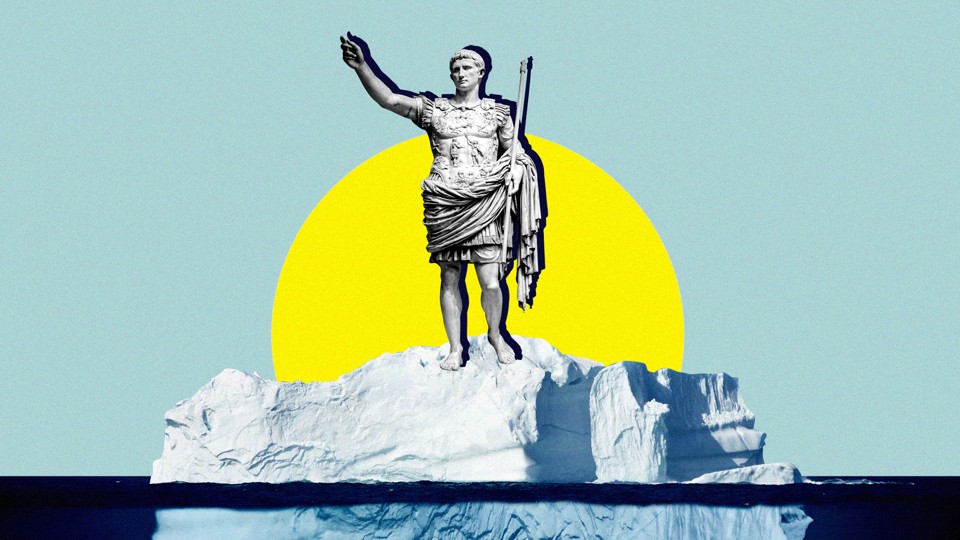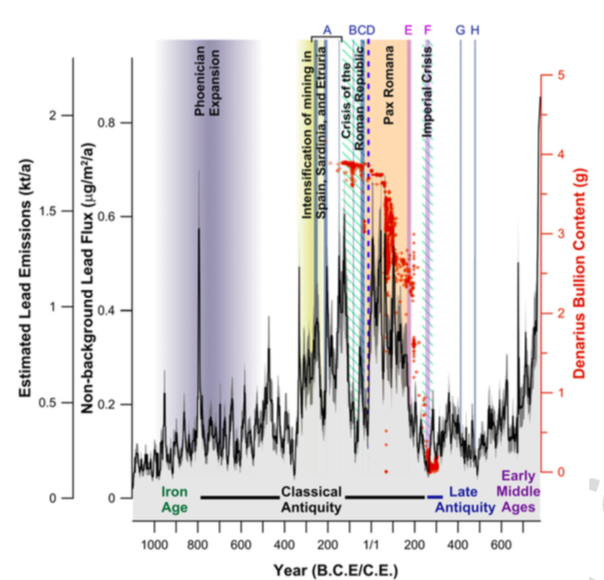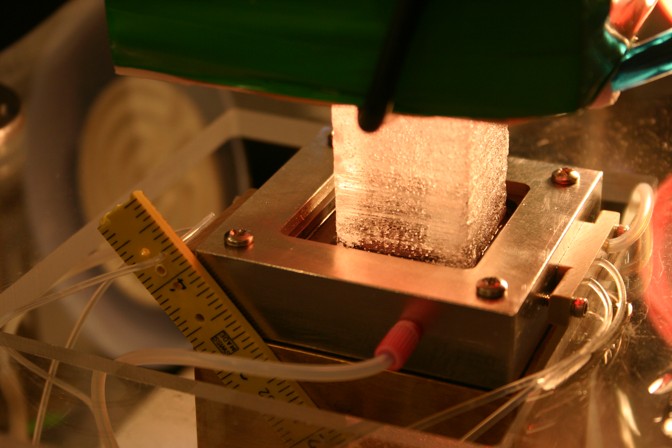Ancient Rome's Collapse Is Written Into Arctic Ice
Scientists can finally track the civilization's economic booms and recessions—thanks to the exhaust of its massive coin-making operation, preserved for centuries in Greenland's ice sheet.
The Atlantic

On March 15, some time ago, several dozen famous politicians—sturdy men, duly elected senators who claimed to love their republic—attacked their chief executive while he walked into the Senate. They stabbed Gaius Julius Caesar 23 times, as he fell to the floor, defenseless, and bled to death, setting off a chain of wars that formally ended the Roman Republic and initiated the Roman Empire.
Some 2,062 years have passed since that day, but we haven't stopped arguing about it. From Central Park productions of Julius Caesar to op-ed accusations of "Caesarism," the Roman dictator—and the world he inhabited—still looms in our political conversation. Even the architecture of Washington, D.C., suggests that it is a kind of New Rome.
But for all those years, the source material for the arguments have remained largely the same. Archaeologists can locate new sites and excavate for coins, plates, or jewelry; scholars can read and reread Roman writers like Cicero, Sallust, and Catullus, who all documented Caesar. These have been the techniques for learning about Rome for centuries, and they are indispensable. But lately, they have been joined by something new.
On Monday, scientists announced the discovery of an entirely new resource that has the potential to remake some of those centuries-old arguments over Roman politics and history. A team of archaeologists, historians, and climate scientists have constructed a history of Rome's lead pollution, which allows them to approximate Mediterranean economic activity from 1,100 B.C. to 800 A.d. They found it hiding thousands of miles from the Roman Forum: deep in the Greenland Ice Sheet, the enormous, miles-thick plate of ice that entombs the North Atlantic island.
In short, they have reconstructed year-by-year economic data documenting the rise and fall of the Roman Republic and Empire. The first news of the record was published Monday afternoon in Proceedings of the National Academy of Sciences.
Why does the amount of lead in the atmosphere tell us something about the Roman economy? "It's a proxy for coin production. That's the biggest thing," said Seth Bernard, a professor of ancient history at the University of Toronto. When the Roman government needed to pay for something, it ordered the creation of new silver coins. These coins were produced, in part, in mines on the Iberian peninsula. But these mines didn't excavate pure silver: Instead, they unearthed an ore of silver, lead, and copper that had to be smelted into silver. This process filled the air with lead pollution.
Once in the air, these lead emissions did not stay in one place. Instead, it wafted with the winds, eventually blowing into squalls and storms over Greenland. When these storms deposited lead-tainted snow or sleet over the Arctic island, the precipitation fused with the ice sheet and became its newest layer. Century upon century of snow and ice fell on the ice sheet, burying but never disturbing that old layer of ice—until 1999, when climate scientists began coring the ice sheet at the NGRIP site. Four-inch tubes, documenting those ancient layers of snow and sleet, were hauled to the surfaces and pristinely preserved.
"There isn't anything close to this detailed" documenting the Roman economy, said Joe McConnell, a professor of hydrology at the Desert Research Institute and one of the authors of the paper. "Our record is dramatically different both in its temporal resolution and in its dating precision."
"The paper speaks for itself," said Seth Bernard, who had early access to its findings but did not work on the research. "It feels sort of like we've discovered the Americas. There was another continent over there, that was always there, that we can see now. And I think that continent is scientific approaches."
The new paper contains findings that Roman historians can already apply to their work. It finds that Rome's economy waxed and waned, following well-documented events in its history, including wars and plagues. In 218 B.C., for instance, when Rome fought with Carthage in the Second Punic War, lead pollution appears to fall—and then it rises, abruptly, as Roman soldiers seized Carthaginian mines in southern Spain and put them to use. It also detects nonviolent events: When Rome debased its currency, reducing the amount of silver in each denarius coin in 64 A.d., lead pollution in the air fell.
And it provides crucial economic context for some of the most pivotal events in Roman history, including the death of Julius Caesar (and the birth of Jesus of Nazareth). The Crisis of the Roman Republic—the series of civil wars and political strife, spanning 134 B.C. to 27 B.C., that brought the Roman Republic to an end— were associated with a broad period of economic stagnation and disintegration, the study finds. And the early Roman Empire—especially the Pax Romana, the 206 years of mostly uninterrupted peace throughout the Mediterranean—were accompanied by an economic boom. When compared with other studies, research suggests that Western Europe may have seen higher lead emissions during the Pax Romana than at any time prior to the Industrial Revolution, nearly 1,800 years later.
This finding reverses a widely cited study from the 1990s that reached almost exactly the opposite finding. That paper, which used a similar but rudimentary technique to pull lead emissions out of the Greenland ice, argued that Roman economic productivity peaked during the late Republic, then stagnated throughout the entire Roman Empire. But that study drew from 18 data points; this new research made 25,000 different measurements of the ice core.
How Lead Emissions Align With Roman and Mediterranean History

"Lead pollutants have become enormously important because they give us information that we don't get from literary sources. The one chart that's there—I can already see that chart being produced in 50 articles over the next 10 years," said Bernard about the above graph. "It's great stuff."
Lead emissions are not a perfect record of Roman prosperity, however, because scholars still don't know how Rome thought about its economy. Coins were clearly important: At the height of the Roman Empire, coins were so standardized that the same money could theoretically be used to buy goods, services, and slaves across modern-day Syria, Spain, Italy, and Turkey.
"The size of this integrated monetary zone is unparalleled," said Bernard. "And the volume of coinage seems larger than any time before or afterward—it really shows the integration of the Roman economy and the level of trade that was going on."
Yet for all these coins, it remains unclear how Rome managed its money in a modern sense. "What we'd love to have is a document that says Rome had a state monetary policy," said Bernard. But none have ever been found. So scholars have argued about whether Roman leaders ignored liquidity or inflation, simply ordering a new round of coins whenever the government faced a large expense; or whether leaders managed money more strategically. Nero's order to debase the currency in 64 a.d. suggests that the Empire, eventually, did see some value in increasing the amount of money in circulation.
The study would not have been possible without three methodological advances, researchers told me.
First, computer models of the atmosphere have significantly improved over the last two decades. These simulations allow scientists to estimate how air from the Iberian peninsula—air that, in Roman times, would have been full of lead pollution—wafted up to the Greenland ice sheet. It also allowed them to distinguish between air from the Iberian peninsula specifically and ambient air from farther east in Europe. This has its historical uses, too: The study documents a rise in ambient lead quality starting in 800 B.C., which coincides with the expansion of the wealthy Phoenician civilization into the western Mediterranean.
Second, chemists and hydrologists have become more adept at finding trace amounts of mineral in the ice core. In the 1990s, researchers could only analyze the pollution in ice cores by peeling tiny shavings of ice off of them. Now, labs use highly sensitive mass spectrometers to measure the presence of 35 different elements and chemicals at once.
These techniques are constantly improving. The new study uses more than 25,000 observations of the ice core across 2,000 years of time. Alexander More, a climate scientist and a historian at Harvard University, told me that another team is working on a technique that can generate 2 billion data points across a 2,000-year ice core—and do it without destroying the ice in any way.

Finally, researchers have gotten better at precisely tying each of those observations to a specific year. Over the last decade, scientists have worked together across fields—including climate science, geochemistry, and volcanology—to unify the "dating" of important climate records. Most importantly, they have learned the precise year that every major volcanic eruption in the last 2,500 years occurred and identified these eruptions in a wide set of natural climate records. Ice cores from Greenland and Antarctica, as well as tree rings from around the world, all show a distinct chemical signature left behind by the eruption of the massive Indonesian volcano Samalas in 1257. Using that eruption and others, as well as a number of other anomalies, scientists can "count backward" in ice cores and tie each layer in the ice to a specific year.
"We think the uncertainty in our age scales is about one to two years, even in antiquity," said McConnell, an author of the paper. "And that's pretty good. It's a lot better than what archaeologists are used to, I can tell you that."
This specificity allows them to find precise political events in the ice. For instance, even though Rome took over Iberian mines after the Second Punic War, the peninsula saw revolutions and uprisings for centuries. Only in 19 B.C. did Rome's first emperor, Caesar Augustus, conquer the rest of Gaul and place the entire colony under a new administration.
"The big increase [in lead pollution] corresponds exactly—and I mean exactly—to the pacification of Iberia and Gaul by Caesar Augustus. And [Iberia and Gaul] are where this pollution was coming from, so it all makes sense," said McConnell.
That said, the lead record does not seem to mark a few major events in Roman history. The Plague of Justinian, which may have killed half the population of Europe in 541 and 542 a.d., does not seem to feature prominently in the record. Nor does the record encompass the full scope of the Roman coin-minting operation: Many important silver mines sat near Greece and the eastern Mediterranean, and their emissions probably did not make it to Greenland.
Alexander More, the Harvard researcher who was not affiliated with the research, said that even in this study, he remained "interested in knowing how the air [from Iberia] got over to Greenland." His team's own analysis of climate models suggests that air masses tend to travel from Europe's northwest to its southeast, which is the opposite journey that these lead emissions would need to have made. "So there might be input from China here, we don't know," he said. "These are all things that need to be considered."
But above all, he said that he was "very happy" to see the new work. "We are very heartened by the fact that historians and climate scientists and archaeologists are working together to produce interdisciplinary research of this kind," he said.
According to some scientists, lead poisoning played a role in the demise of Rome. So it's ironic that lead provides its own record of what devastated the empire. Starting in 165 a.d., a plague swept out of the east and into the Roman world. The disease, dubbed the Antonine plague, caused fever, diarrhea, and skin pustules. (Some scholars believe it may have been smallpox.) It killed millions of Romans, and it devastated the Roman army in particular.
The Roman economy never recovered. Lead emissions plunged that year, hitting a new baseline that persisted for several centuries. Only in the late fourth century, when a Germanic tribe overthrew the last Western Roman emperor, did emissions fall even lower.
It is a new input in an argument—did plagues doom the Roman empire?—so careworn that even the 18th-century historian Edward Gibbon, who wrote 4,000 pages on Rome's decline, wearied of debating it. And like the rest of the study, it will change how classicists like Seth Bernard go back to the primary sources.
"How we read Cicero, how we read our historical sources of the Gracchi—it does feel like we have new material that we've never had access to before," he told me. "The opportunity lies in taking this new data and rethinking what we have."
And it "all makes sense" that ancient historians would find succor in climate science, he said. "We've known for a very long time that if you're in a world that relies on human power, and calories, and energy—and thus the sun—then what the sun is doing, and what climate is doing, matter a lot," he said.
To that, I would add only: You do not need to return to Catullus and Caesar, Cicero and Catiline, to find a civilization that ran on calories and human power, that relied on the sun and the stable climate. Nor was ancient Rome the only civilization that scattered its exhaust to every corner of the Earth, leaving a record of itself that would have been unimaginable to its own citizens. If you wish to seek out such a civilization, then congratulations: You are living in one right now.
No comments:
Post a Comment